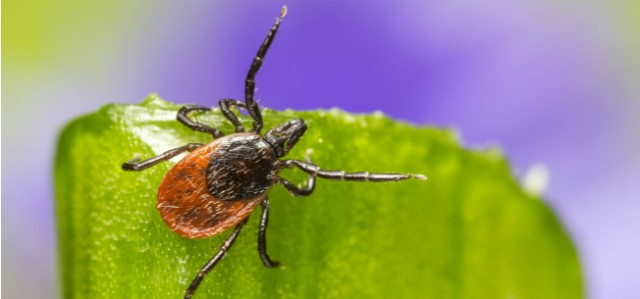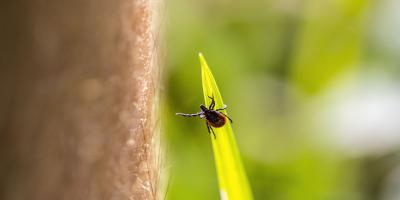7 Tips To Keep Ticks Away This Spring

Thanks to a warmer than average winter and a spring ahead that’s expected to be both cool and wet, it’s looking more and more like the upcoming spring season is going to feature some pretty large tick populations. This will likely have far-reaching effects, figuring into everything from outdoor sports schedules to animal protection all across the Northeast.
For homeowners living in these affected areas, dealing with a boom in the tick population can be tough, and even downright dangerous - especially considering just how many folks get sick from tick-borne diseases every year.
Luckily, we’ve been at this for a while, and we know a few tips to keep ticks at bay in the warm months ahead. Here’s a look at what you can do to keep ticks from feasting on you, your family, and your pets through the spring.
1. Avoid grassy or bushy areas where ticks hide
To a tick, the world is almost entirely smells, temperature changes, and chemical signals - which makes finding prey on their own pretty difficult. That’s why most ticks actually wait for prey to come to them, waiting out in high grass performing a tactic called “questing,” where the tick holds on to a blade of grass or a leaf with its back legs and keeps its front legs extended and ready to grab on to a passing animal.
It may be a lesson already driven into your brain from childhood, but the overall lesson remains the same: ticks hide out in tall grass, and staying away from brush and scrub like this can seriously decrease the risk of picking up a tick. If you do have to head out into tall grass, keep your skin covered - that way, a tick should have nothing good to grab onto.
2. Don't give ticks hiding places - mow lawns, stack wood piles, etc
Ticks rely on tall grasses and shrubs to reach passing prey, and for homeowners this presents one easy solution to help keep ticks from getting too comfortable near your home: mow the lawn regularly. By keeping grass short and regularly maintained, you effectively make your yard inhabitable by ticks. That can make serious headway on keeping your yard tick-free all spring long.
But as much as ticks rely on grass to feed, they also look for somewhere shady and protected to lay eggs and hide from predators. Often, a wood pile offers just that. Homeowners should keep wood piles stacked neatly at least a dozen feet from the house or more, thereby preventing ticks from being able to set up shop where it’s easy to reach you or your family.
3. Use insect repellant or DEET
One of the main signals ticks use to know that a suitable host is passing by is smell: breath, perspiration, and other natural odors attract ticks and give them the signal to hitch a ride and start feasting. Some insect repellents, like DEET, can actually mask those odors from ticks, “blinding” ticks from being able to detect that odor and preventing that feeding instinct from being triggered.
But while DEET may be effective at protecting your skin from ticks in the short term, long excursions into tick territory may take a special level of protection. Some hikers treat their clothes with permethrin, another potent insecticide that can actually kill ticks os they crawl across a treated surface. And since permethrin works to kill mosquitos and other insects, it may be a great option for the warm and tick-heavy months ahead.
4. Treat your pets and keep them tick-free
Even if you and your family are extremely careful about staying tick-free and doing regular tick checks each time you come in the house, that may still not be enough to keep ticks away - especially if you’ve got pets. Dogs, cats, and other domestic pets can easily pick up all kinds of ticks, and can easily transfer these pests into your home and even to members of the family.
Just as it’s important to do thorough tick checks for each member of your family, so too is it critical to make sure your pets are protected and tick-free throughout the season. Whether you opt for commercially-available tick prevention solutions for pets or a thorough check each time they come inside, keeping your pets free of ticks and other mites is critical to staying tick-free all spring long.
5. Keep rodents and other wildlife from getting comfortable
Even though they may not know if they’ve picked up any ticks, your pets are relatively easy to keep tick-free: generally, they’ll sit still long enough to be checked, and you can keep fairly tight control over what they’re bringing into the house. For other critters that might be hanging around your property, however - like mice, rats, bats, and more - this may not be quite so easy.
Simply put, the best way to prevent rodents and other pests from bringing ticks into your home is to keep them all away in the first place. Working with your pest control expert to keep rodents away can be a serious boost to your tick-prevention efforts.
6. Consider keeping tick eaters around - like chickens
As tough as ticks may be to control and even to remove once they’ve gotten hold on an animal, ticks are anything but indestructible. In fact, ticks have a few seriously effective predators in relatively common animals, the most prevalent of which is the common chicken.
Chickens and other poultry (especially guinea fowl) love to eat ticks, and in many cases - mostly when combined with other tick control method - these birds can make an impact on reducing the tick population in their area. While not every home can accommodate chickens or guinea fowl in their yard, those that do may notice an impact on tick control as a result.
7. Call your trusted pest management expert
As effective as many of these DIY tick prevention methods can be, sometimes the situation may just be beyond your ability to control. In the event that your tick issue is truly out of hand, the best course of action may be to call your trusted pest control expert to come take care of the situation.
At JP Pest Services, we utilize an integrated, seasonal Tick Control Program that uses a synergistic blend of botanical oil extracts (thyme, rosemary and wintergreen) combined with synthesized derivatives of naturally occurring pyrethrins found in the Chrysanthemum flower. This combination is powerfully effective, and involves includes three treatments per season throughout spring, mid-summer, and fall.
Whether you’ve experienced a tick problem in the past or you’re bracing for a particularly tick-heavy season ahead, JP Pest Services can help get your situation under control so you can enjoy the spring free from worry. Get in touch and let us get started on your tick control plans so you can get out and get on with your warm-weather plans.



